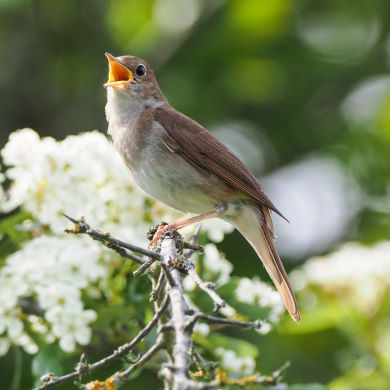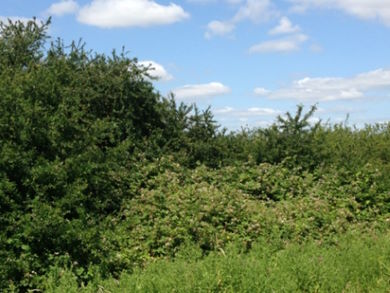The Kent Ornithological Society is conducting a survey of Nightingales in Kent during 2023.
 Nightingale © Barry Wright
Kent probably holds more Nightingales than any other county in Britain.
This iconic nocturnal songster features strongly in literature and folklore here and throughout its range and is a species we don't want to lose. Nationally, the species has experienced a considerable south-easterly contraction in range and numbers. In Kent, repeated surveys since 1969 have resulted in counts of around 1,000 singing males and identified several key Nightingale "hot spots". However, the surveys have also revealed a change in the preferred habitat with some traditional woodland types being abandoned in favour of dense scrub.
The last survey was the national BTO survey in 2012 (see here), which showed that a decline in range and probably numbers was starting to occur in Kent.
This was also evident from comparisons of the last two Atlas maps (see here).
Over ten years on, it's now time to re-survey Nightingales to establish what further change in range and population has occurred in the county, to aid the species' conservation.
Nightingale © Barry Wright
Kent probably holds more Nightingales than any other county in Britain.
This iconic nocturnal songster features strongly in literature and folklore here and throughout its range and is a species we don't want to lose. Nationally, the species has experienced a considerable south-easterly contraction in range and numbers. In Kent, repeated surveys since 1969 have resulted in counts of around 1,000 singing males and identified several key Nightingale "hot spots". However, the surveys have also revealed a change in the preferred habitat with some traditional woodland types being abandoned in favour of dense scrub.
The last survey was the national BTO survey in 2012 (see here), which showed that a decline in range and probably numbers was starting to occur in Kent.
This was also evident from comparisons of the last two Atlas maps (see here).
Over ten years on, it's now time to re-survey Nightingales to establish what further change in range and population has occurred in the county, to aid the species' conservation.
For the 2023 survey, the aim is to get volunteers to visit selected 1km squares across Kent and for them to record all singing Nightingales, to contribute to a county population estimate and to identify important areas for the species. The visits need to be during early morning from first light and should be made on two different occasions between late April and mid/late May.
 Nightingales have a basic requirement for dense undergrowth that may be met by a wide range of habitat types.
Singing birds might occupy thorny scrub, bramble, young coppice and regenerating woodland, willow carr, or young conifer plantations with a good shrub layer. Thus, any landscape that holds these habitats might be occupied. Birds can sometimes be found on farmland, in patches of scrub, woodland, dense hedgerows or shelterbelts. Mature woodland is unlikely to be suitable but may conceal patches of suitable habitat.
In urban areas, undisturbed areas of scrub (such as railway embankments) might hold the species.
Nightingales have a basic requirement for dense undergrowth that may be met by a wide range of habitat types.
Singing birds might occupy thorny scrub, bramble, young coppice and regenerating woodland, willow carr, or young conifer plantations with a good shrub layer. Thus, any landscape that holds these habitats might be occupied. Birds can sometimes be found on farmland, in patches of scrub, woodland, dense hedgerows or shelterbelts. Mature woodland is unlikely to be suitable but may conceal patches of suitable habitat.
In urban areas, undisturbed areas of scrub (such as railway embankments) might hold the species.
Survey instructions and recording forms, along with a map of the selected 1km square, can be downloaded from this website and printed. To get started, view the county map to see the available survey squares.
Survey website developed by Garganey Consulting
